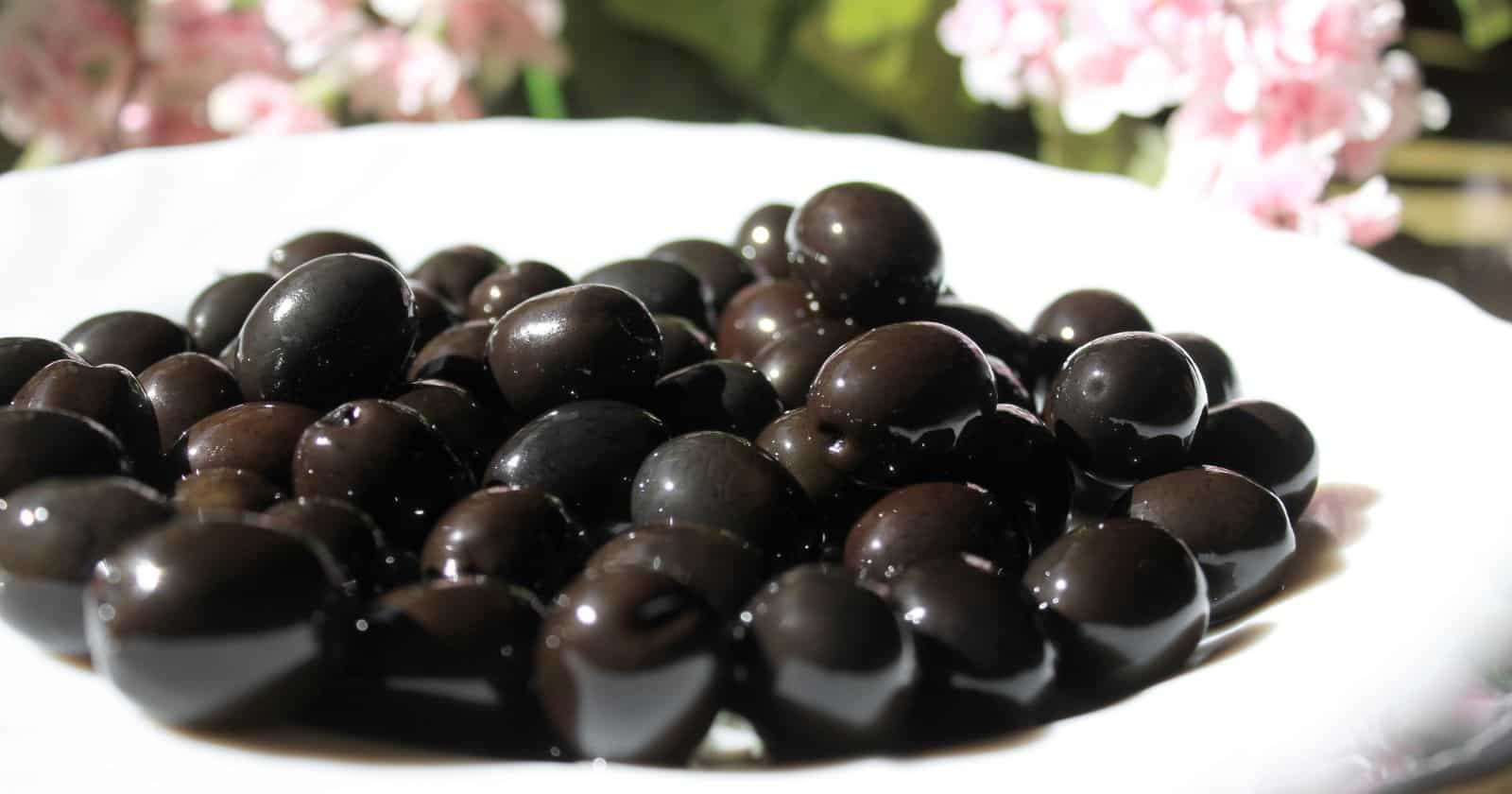Kalamata olives are more than just a tasty addition to your favorite Mediterranean-inspired dishes – they’re also a way to bring a taste of Greece to your table.
But if you’re unfamiliar with this type of olive, you may wonder what the fuss is about.
In this article, we’ll dive into the history and flavor profile of Kalamata olives, explore their health benefits, and share some delicious ways to use them in your cooking. Let’s get started!
A Brief History of Kalamata Olives
The olive tree, in general, is an ancient plant that can be traced to the East Mediterranean region. Kalamata olives are a black olive variety from the Kalamata region in Greece. These olives are one of the most beloved Greek olive varieties grown in many countries worldwide, including Australia and the USA.
The history of Kalamata olives is as rich as its flavor. Archaeological evidence suggests that the ancient Greeks enjoyed consuming olives as early as 5000 BCE. Kalamata olives themselves, however, have only been around for roughly a century. These olives were created in the late-nineteenth century by a Greek priest named D. Rodolakis.
Kalamata olives are known for their distinctive taste, texture, and color. They are naturally ripened and sun-dried, producing a rich, meaty flavor. These olives are also known for their versatility, as they can be used in countless recipes, from meze plates to pasta dishes.
Nowadays, Kalamata olives are widely produced worldwide, with many regions vying to create their unique takes on this classic olive. However, the original Kalamata olive remains the most highly-regarded and sought-after variety.
Kalamata Olives: Flavor Profile and Characteristics
Kalamata olives are not your average olive. They have a flavor profile that sets them apart from others. These olives have a rich, fruity, and meaty taste with a sharpness that makes them stand out. They are bitter when first harvested, but their flavor becomes more pronounced after the curing process.
Compared to black olives, Kalamata olives have a milder taste, almost sweet and fruity, but with the sharpness that black olives provide.
Castelvetrano olives are another variety of olives with a unique flavor profile. These green, unripe olives taste salty and sweet at the same time. However, their flavor profile is different from Kalamata olives. Kalamata olives have a more robust and complex taste, making them a great addition to many dishes.
Kalamata olives’ strong flavor profile makes them versatile and delicious. Their sharpness cuts through different flavors, making them standout ingredients in many recipes. They lend themselves well to salads, pasta, pizza, dressings, and other dishes.
Health Benefits of Kalamata Olives
Kalamata olives are a true superfood! Packed with essential nutrients, these olives are tasty and highly beneficial to your health. A rich source of oleic acid, a monounsaturated fat that protects your heart and helps prevent cancer, Kalamata olives are a must-try for anyone looking for better health.
But that’s not all! The Health Benefits of Kalamata Olives extend beyond oleic acid. These olives are a veritable powerhouse of other essential minerals and vitamins. They contain iron, calcium, copper, and vitamins A and E, all necessary for strong bones, healthy skin, and better immunity.
And with their high antioxidant content, Kalamata olives help you fight against serious diseases such as dementia and diabetes.
Like all olives, Kalamata olives contain a good deal of sodium. Of course, it’s essential to eat these olives in moderation. But by adding them to your daily diet in small amounts, you can enjoy this superfood’s benefits without worrying about going overboard.
How to Use Kalamata Olives in Your Cooking
Kalamata olives are a versatile ingredient that can add flavor to your cooking. They pair well with fish and poultry, making them a great addition to any Mediterranean-inspired recipe. However, there are so many other creative ways to use them! Use them in various ways to enhance the taste of your dishes.
Here are some ways to use Kalamata olives in your cooking:
- Add them to salads – Kalamata olives go well in various salads. They pair well with citrus fruits, tomatoes, and feta cheese. Try creating a simple salad with chopped kale, thinly sliced fennel, and crumbled feta cheese, then top it with olives and a drizzle of olive oil.
- Use them in dips – Kalamata olives can be the show’s star when it comes to dips. Try making a delicious Kalamata Olive Dip by blending the olives with garlic, lemon juice, and Greek yogurt. The drop is perfect for serving with pita chips or fresh vegetables as a snack.
- Use them as a crust – Kalamata olives can also be used for meat or fish. Pulse the olives in a food processor until they form a paste, then spread it on top of your protein. Bake the dish as usual for a delicious and flavorful crust.
- Stuff them with cheese – For a quick and easy appetizer, stuff Kalamata olives with crumbled feta cheese. It’s a simple yet delicious snack that will satisfy your craving for something savory.
How to Select and Store Kalamata Olives
Kalamata olives are a popular ingredient in Mediterranean cuisine. To select fresh kalamata olives, always choose recently harvested and unbruised olives.
Kalamata olives can be stored in the refrigerator to keep them fresh, either opened or unopened. When buying them from a jar, confirm that the seal is not broken and check the expiration date.
If you’re growing olives at home, place tarps under the trees and gently dislodge the olives with a rake. After gathering the olives, the easiest and quickest way to cure them is by using water.
In this method, the olives are sliced or cracked to expose the flesh and then soaked in water for several days until they become less bitter.
Once you’ve harvested your kalamata olives, you’ll want to preserve them to savor their flavor year-round. Here are some methods to keep your olives fresh and delicious:
- Pickling: Soak the olives in brine for several weeks to create a tangy, sour flavor.
- Salting: Pack the olives in salt to pickle them and create a unique flavor profile.
- Oil-curing: Marinate the olives in oil for several weeks, producing a rich, smooth texture and flavor.
Pairing Kalamata Olives with Other Mediterranean Ingredients
Kalamata olives have a complex and robust flavor, making them an ideal ingredient to pair with many Mediterranean foods. These olives originate from Greece and have a distinct taste that is both salty and slightly sour.
If you’re looking for the perfect pairing to complement these unique olives, look no further! Kalamata olives are perfect for Parmigiano Reggiano cheese, salami, walnuts, Sauvignon Blanc wine, and Pilsner beer.
But that’s not all! Kalamata olives also pair well with Provolone cheese, feta cheese, garlic, lemons, and parsley. These olives can elevate any dish, whether it’s fish, poultry, roasted cauliflower, or a citrus salad. Kalamata olive brines can be an excellent addition to rosemary, lemon rinds, or garlic cloves.
Here are some more details on how Kalamata olives can be paired with other Mediterranean ingredients:
- Cheese: Kalamata olives pair well with various types of cheese, including Parmigiano Reggiano, Provolone, and feta. All of these cheeses complement the rich and robust flavor of Kalamata olives.
- Nuts: Try pairing Kalamata olives with walnuts for an added crunch. The nutty flavor of the walnuts balances the salty taste of the olives.
- Wine and Beer: Kalamata olives are a popular drinking snack that pairs perfectly with Sauvignon Blanc or Pilsner beer. The wine’s dryness and crispness cut through the olives’ saltiness, while the beer balances the flavors.
- Seasonings: Kalamata olive brines can enhance any dish. Try including rosemary, lemon rinds, or garlic cloves to create a savory, tangy marinade.
Kalamata Olives vs. Other Types of Olives: What’s the Difference?
Kalamata olives stand out from other types of olives in terms of flavor, texture, and size. They are dark purple and have a distinct almond shape distinguishing them from rounder, milder black olives.
Compared to black olives, they have a more intense taste with fruity notes thanks to being allowed to ripen fully.
The curing methods for Kalamata and Sicilian olives are similar, but Kalamata olives can be packaged in wine vinegar and herbs or simple salt brine.
If you’re interested in exploring the differences between types of olives further, here are some more detailed points to consider:
- All olives start as green on the vine and change color as they ripen. Green olives are typically picked earlier in the season, while black olives are left on the tree until they fully ripen. Kalamata olives are one of the few exceptions to this rule, as they are allowed to fully ripen and then soaked in a salt brine to develop their signature taste and texture.
- Kalamata olives are often used in Mediterranean cuisine and pair well with bold flavors like feta cheese, tomatoes, and garlic. Black olives are more commonly used in American-style pizzas and sandwiches.
- Kalamata olives are a good source of healthy fats and antioxidants, while black olives are slightly lower in calories and fat. However, both types of olives are nutritious choices when eaten in moderation.
- Other famous olives include green olives, typically stuffed with pimentos or garlic, and Castelvetrano olives, which have a bright green color and a buttery, nutty flavor.





